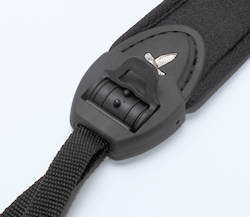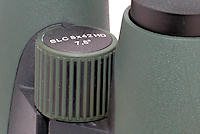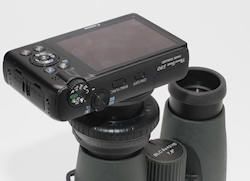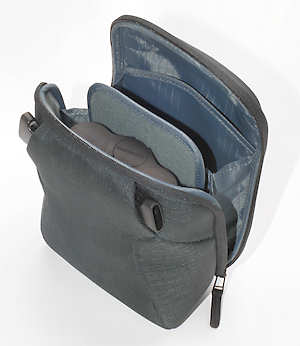Swarovski 42-mm SLC HD Binoculars
|
|
Review Highlights
- Re-designed
with HD glass
- 6-foot
minimum close focus
- New
lighter weight magnesium chassis
- Wide-angle
eyepieces yield a large field of view
- Digi-binning
capability included in the box
|
After completely re-designing
the EL, Swarovski decided not to rest on their laurels, and just months
later, released the new HD version of their old SLC binocular in Europe.
Not as well known among birders, particularly in America, the old SLC
was usually thought of as being more of a hunter’s binocular. SLC (which
stands for “slim, light, compact”) binoculars comprise an extended
product line, available in 8x and 10x56, 7x, 8x and 10x50, 8x and 10x42
and 8x30 models. All SLC binoculars are single-hinge, roof prism designs.
At this point, only the 42-mm models are offered with HD glass, and it
is unclear how many, if any, of the other old SLC binoculars will be re-issued
in HD versions. We received both the 8x42 and 10x42 HD SLC binoculars
for review, and this article is only about those models.
Overview
Upon first glance, the new
SLC HDs look pretty much like the old SLCs, but there are major differences
that emerge with a closer look. The old SLCs came in 7x42 and 10x42 versions
while the new SLC HDs substituted an 8x for the 7x42 model. The new SLCs
have slimmer ocular tubes and are slightly shorter. This, along with the
use of magnesium chassis beneath the armoring, contributes to a real difference
in weight: the new SLCs are 3-5 oz. lighter than the old ones. Swarovski
also significantly upgraded the glass and coatings in the new SLCs, improving
the optical performance across the board. The focusing system was redesigned,
and the diopter adjustment mechanism was made intrinsic to the focus knob.
Optical
Properties
The new SLC HD binoculars are
very bright. They are made with the same fluoride-containing HD glass
found in the EL Swarovisions. Due to the fact that the SLCs lack the field-flattening
lenses of the ELs, the SLCs are actually a tiny bit brighter. This represents
a substantial performance enhancement on what was already an excellent
binocular. Optically, the new SLC HDs sit comfortably on a par with the
very best binoculars available today from any manufacturer. The sharpness
and contrast are truly excellent and the colors are vibrant and true.
In terms of depth of field, we compared the SLC HD binoculars with the
best we knew of in that regard, and we were pleasantly surprised to discover
that they bested the performance of one of them and were equal to the
other. Suffice it to say that the depth of field on the new SLCs is very
impressive indeed.
Another significant change
to the 42-mm SLC HDs is in the ocular lens design. Swarovski literature
speaks of the wide-angle eyepieces that yield a particularly wide field
of view. The 8x SLC has a remarkable 408-foot field of view at 1000 yards,
while the 10x model has a more pedestrian 330-foot field. That’s still
above average for high-end binoculars, though not as strikingly so as
the 8x. The SLCs have 18.5 and 16 mm of eye relief on 8x and 10x models
respectively. That’s enough to be comfortable for most users but is
slightly below average relative to other 42-mm binoculars of the corresponding
magnifications.
Coatings
The new SLC HD binoculars feature
the same advanced coatings found on the EL Swarovision binoculars. Swarovski
SLC HD binoculars are fully multi-coated and phase-coated. The Swaroclean
coating on the outside surfaces of the lenses makes water bead up and
drop off more quickly. The same coating also tends to prevent dust or
dirt particles from sticking, so it generally helps maintain a clearer
cleaner view. The remaining three coatings are found on the lenses and
prisms. The Swarobright coating improves color fidelity throughout the
spectrum of visible light. The Swarodur and Swarotop coatings which maximize
brightness and contrast. How all these coatings actually do what they
do is probably too technical for this venue, but the key observation is
that they really do work!
Dimensions

Rollover
image with mouse
Swarovski SLC binoculars are
roof prism binoculars of a single-hinge design. They are about 6.25 inches
long with the eyecups fully extended and almost exactly 5 inches across
with the hinge at its widest setting. We weighed them in at 29.3 oz. and
28.1 oz. for the 8x42 and 10x42 models respectively.The tethered objective
lens covers and rain guard add another 2.3 oz. of combined weight, which
is relevant since most people will carry those into the field with the
binocular. These weights are a bit high, relative to the general class
of 42-mm roof prism binoculars, but there are other considerations. First,
the SLCs are fully armored and have durable magnesium chassis – these
are really solid and well-constructed, able to take a fair pounding in
the field without any loss of function. Further, in the hands, they don’t
feel as heavy as they actually are, largely due to the great balance of
these binoculars. The SLCs fit the hands perfectly, almost asking you
to use them. Nothing else, including their mass, crosses your mind. The
interpupillary distance range of the new SLC binoculars is 56-74 mm. This
means that these binoculars will comfortably fit most people unless they
have an unusually wide or narrow face. And of course, these binoculars
are fully sealed and nitrogen-purged to be dust-proof, internally fog-proof.
Focusing
We tested the SLC HD binoculars
and found both to have a minimum focusing distance of 6 feet without appreciable
field collapse. That is very good performance for 42-mm roof prisms in
general, and achieving it without field collapse is even better. The new
SLCs go from minimum close focus to infinity in 2 full turns of the focus
knob. We wrote about this extensively in the EL Swarovision review (see
here) and while the justification sounds pretty good, the bottom line
is that this feature will frustrate some people. Yes, this mechanism confers
great precision in focusing, but if the subject is on the wing (and birds
have an annoying habit of flying…) it’s often too slow.
User
Adjustments

Rollover image with mouse
The diopter adjustment is concealed
under the focus knob. To adjust the diopter, focus the left ocular on
something, and then without changing that focus, pull the knob up towards
yourself until it clicks open. A scale of +/- 4 diopters relative to equal
appears. Note, the “0” point is marked by a raised line on the hinge
mount, and it is actually+ at about 9:30 – 10:00 rather than straight
up (12:00). Frankly, they could have made that a bit more obvious, though
it’s a trivial point. Adjust focus through the right ocular with the
knob until it becomes sharp, and then close the mechanism by pushing the
knob down. There are five click-stops within each diopter. The click stops
help hold the knob position steady as you close the mechanism, but it
still requires a light touch. The eyecups adjust with a helical twist
mechanism: counter-clockwise moves the eyecups outward, clockwise adjusts
them inward. There is a stable intermediate position between fully-in
and fully-out. The mechanism has a “mushy” feel to it but the eyecups
go into a sort of pseudo-lock if you keep twisting them when they are
all the way out. The locked position is quite stable.
Digi-binning

Rollover image with mouse
The new 42-mm SLCs have a new
capability relative to the previous models: you can digi-bin with them.
Swarovski includes a digi-binning adaptor with each binocular that allows
you to attach a point-and-shoot digital camera to your binocular. This
turns the binocular into a telephoto lens for the camera (provided it
has an extendable lens of suitably small diameter). Achieving truly artful
photography with a digi-binning set-up is difficult at best – it takes
a lot of practice. That being said, getting documentation quality photos
with a digi-binning set-up is a very realistic goal, and this may be where
the equipment really comes into its own.
Covers
and Case
 The
objective lens caps are made of soft rubber with rings that fit around
the barrels of the binocular. The caps dangle nicely and fit snugly yet
easily over the rims of the barrels. The interesting thing is these caps
actually have a hard insert for the section of the cap that covers the
lens so that something impacting the center of the cap can’t push back
onto the surface of the lens itself. Generally, these are great lens caps
– functional and without significant drawbacks. The rainguard is the
same as the one on the EL Swarovsions: a hard plastic unit that fits firmly
on the rubber of the eyecups. The hinge adjusts through a series of micro
click-stops, oddly enough, over a broader range than the binoculars themselves
can achieve. The strap slips through a bracket on either side of rainguard.
The neck strap is a composite of neoprene-like material stiched to leather
and plastic hasps that attach to a thin cordura-type strap. The soft neoprene
segment is molded to curve naturally around your neck. The length of the
strap adjusts through a gear: pull a lever on the gear to release the
strap for adjustment, and then snap the lever back to lock in the new
position. It’s a very slick adjustment. Swarovski also markets their
own harness called “Bino Suspenders”. While the strap is fine as it
goes, we recommend using a harness on a binocular of this weight. The
case is brand new, made of waterproof nylon like material and closed with
a pair of zippers. The large compartment inside is divided by a stiff
wall with the binocular clearly intended to fit behind that wall, and
a pouch in front for things like a lens cloth, the digi-binning adaptor,
a lens pen, a small notebook or whatever. The dividing wall has its own
expandable net pouch on the front side for storing small items. Swarovski
includes a detachable strap for the case itself – after all, all those
pockets mean nothing in the field if you don’t carry it in the field!
The strap is an adjustable 2-inch wide cord that attaches by means of
a pair of double-toothed clasps for ease of use. This is a much better
case than that originally shipped with the new EL Swarovision binoculars.
Swarovski now ships this case with the Swarovisions too.
The
objective lens caps are made of soft rubber with rings that fit around
the barrels of the binocular. The caps dangle nicely and fit snugly yet
easily over the rims of the barrels. The interesting thing is these caps
actually have a hard insert for the section of the cap that covers the
lens so that something impacting the center of the cap can’t push back
onto the surface of the lens itself. Generally, these are great lens caps
– functional and without significant drawbacks. The rainguard is the
same as the one on the EL Swarovsions: a hard plastic unit that fits firmly
on the rubber of the eyecups. The hinge adjusts through a series of micro
click-stops, oddly enough, over a broader range than the binoculars themselves
can achieve. The strap slips through a bracket on either side of rainguard.
The neck strap is a composite of neoprene-like material stiched to leather
and plastic hasps that attach to a thin cordura-type strap. The soft neoprene
segment is molded to curve naturally around your neck. The length of the
strap adjusts through a gear: pull a lever on the gear to release the
strap for adjustment, and then snap the lever back to lock in the new
position. It’s a very slick adjustment. Swarovski also markets their
own harness called “Bino Suspenders”. While the strap is fine as it
goes, we recommend using a harness on a binocular of this weight. The
case is brand new, made of waterproof nylon like material and closed with
a pair of zippers. The large compartment inside is divided by a stiff
wall with the binocular clearly intended to fit behind that wall, and
a pouch in front for things like a lens cloth, the digi-binning adaptor,
a lens pen, a small notebook or whatever. The dividing wall has its own
expandable net pouch on the front side for storing small items. Swarovski
includes a detachable strap for the case itself – after all, all those
pockets mean nothing in the field if you don’t carry it in the field!
The strap is an adjustable 2-inch wide cord that attaches by means of
a pair of double-toothed clasps for ease of use. This is a much better
case than that originally shipped with the new EL Swarovision binoculars.
Swarovski now ships this case with the Swarovisions too.
Conclusions
Let’s see, what are we missing?
Oh yeah – the price! The new SLCs cost
$2,129.00
for the 8.x model and
$2,239.00
for
the 10x model. The new HD Swarovski SLC binoculars provide a huge jump
in performance over the old ones, which is saying a lot since they were
pretty darned good before. The addition of HD glass and use of the more
advanced coatings puts this second line of Swarovski’s right into the
top echelon of binoculars available today. The image is bright, razor
sharp and has great depth of field. These binoculars feel great in the
hand. What used to be primarily a hunter’s binocular is now a world-class
nature-watching optic.
The HD version of SLC binoculars have been discontinued. The new SLC binoculars have the same quality optics although the close focus
is now 10.5ft. and they are slightly brighter because the close focus lens element was removed. Find them here: new Swarovski SLC.